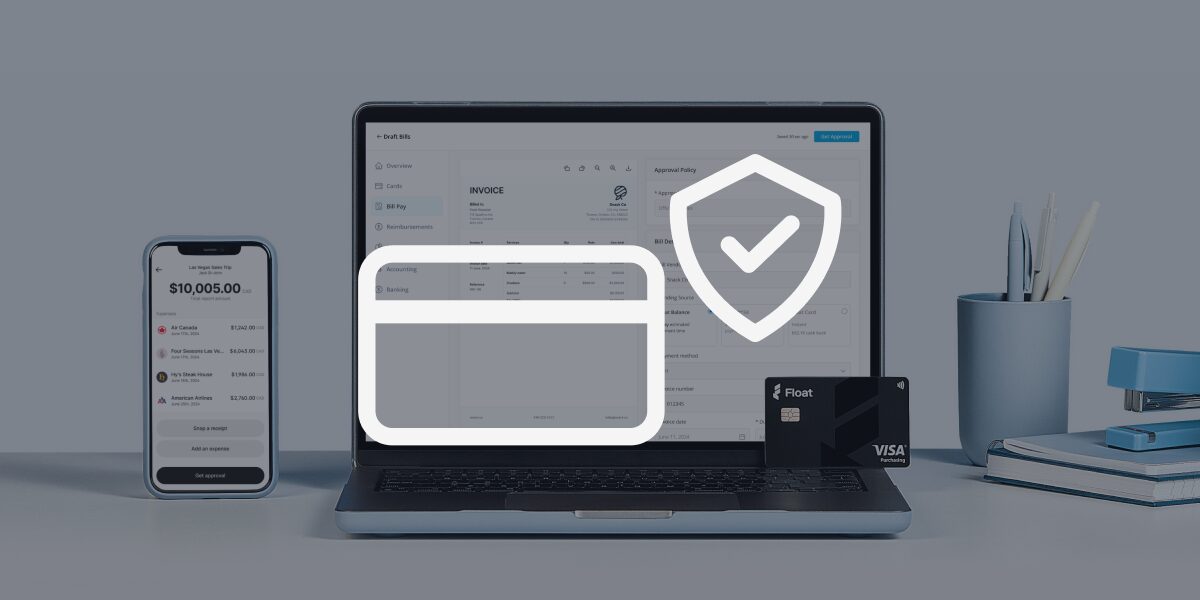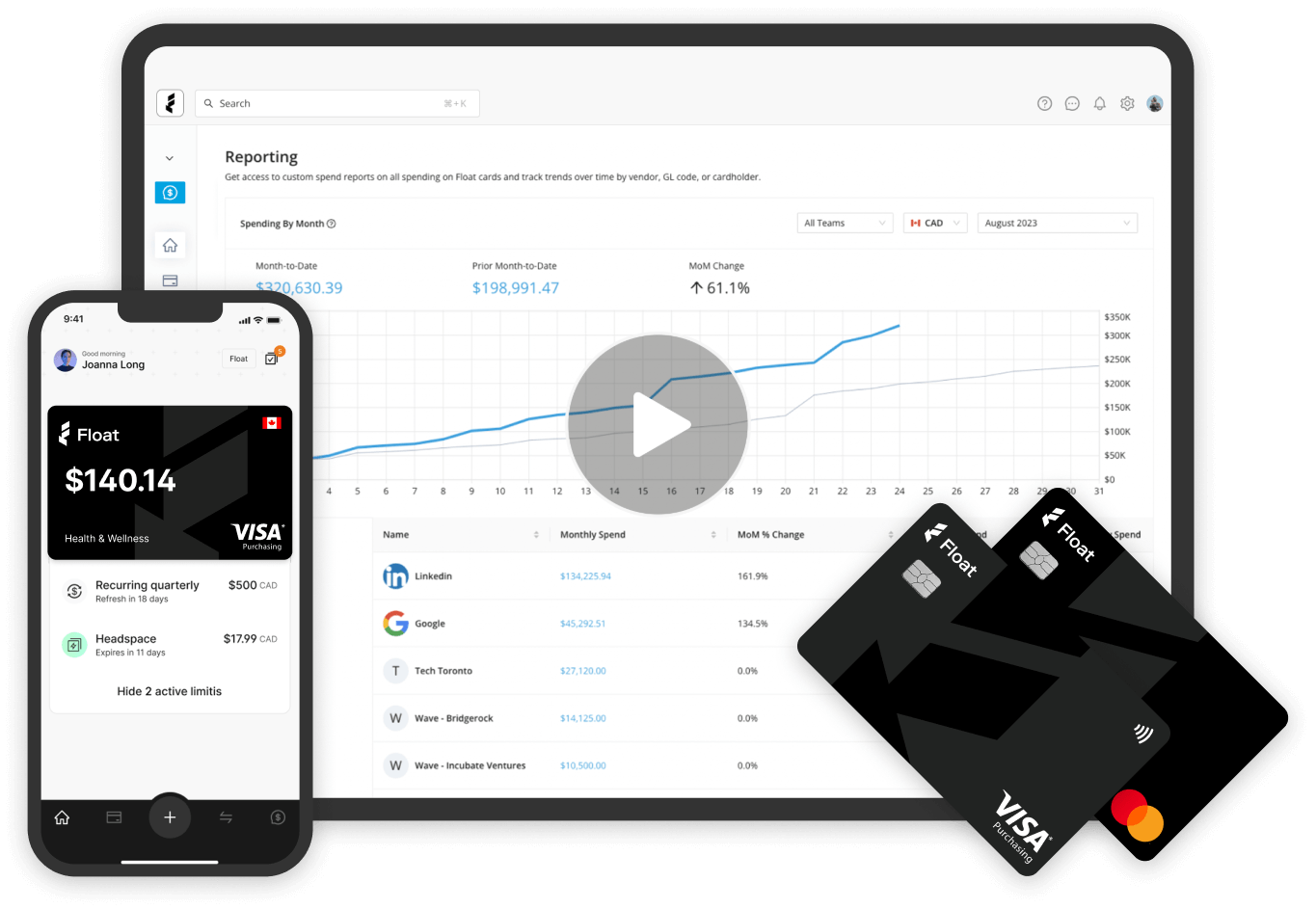Corporate Cards
How to Control Employee Spending: 5 Tips for Finance Teams
Employee spending out of control? These five tips for finance teams will help you control employee spending with ease, without slowing anybody down.
July 10, 2025

Handling company finances can sometimes feel like playing a never-ending game of whack-a-mole. Every time you knock down one expense, a new one pops up. For Canadian finance teams, a lack of proper expense management can lead to frustration and a sense of never regaining control.
You already know that effective spending controls are crucial for preserving a business’s financial health and operational efficiency. The right controls allow finance teams to minimize unnecessary spending, ensure compliance and align employee expenses with company budgets and long-term goals. But how exactly can you implement them—and make them stick?
Here are five key tips to help you control employee spending effectively, as shared by the finance experts at Float.
1. Establish clear expense policies
Implementing corporate spend controls begins with developing clear and easy-to-understand expense policies for your team. Your expense policy should outline a number of key details, including:
- Permissible spending categories
- Employee expenses eligible for reimbursement
- Employees eligible for company spending
- Spending limits per category
- Processes for writing and approving expense reports
- Documentation requirements
- Employee reimbursement workflows
In addition to specifying acceptable spending, expense policies should also outline non-reimbursable expenses. Think personal expenses, meal and travel expenses with no business purpose or purchases from unapproved vendors.
Clear, relevant and current expense policies are one way to prevent unauthorized purchases and build team accountability around spending company money. Check out this free expense policy template from Float to create a comprehensive and current expense policy with ease.
2. Leverage technology for real-time monitoring
A key part of managing employee spending is knowing when, where and why employees are spending in real time. If you find out about an egregious expense three months after the fact, it can be more challenging to deal with than if you find out the same day it happens.
Many successful Canadian finance teams implement automated expense management tools with corporate spend controls to track and analyze employee spending. These tools not only provide up-to-the-minute details on employee expenditures but also enable finance teams to spot spending patterns and anomalies. This data is essential for creating accurate budgets and managing cash flow effectively.
Float’s expense management technology offers real-time visibility into your company’s financial data, including every transaction. This way, your finance team can view every detail of day-to-day employee spending, as well as company spending over time, for a more comprehensive understanding of your overall budget.
3. Introduce corporate cards with spend controls
This may seem like a controversial take, but when it comes to controlling spending, you have to give employees some room to breathe. One way to provide that flexibility is to introduce corporate credit cards for key team members.
You may be thinking: Isn’t giving my team credit cards going to increase their spending?
Not necessarily.
Corporate cards that come with customizable controls are a highly effective way to provide employees with spending flexibility while maintaining financial control over company expenses. For example, Float’s corporate card comes with real-time controls and role-based limits, allowing finance teams to determine the spending limits for employees using company cards.
Float’s corporate cards also have automated expense reporting, reducing the need for manual expense submissions. With automated receipt capture, employees can instantly send receipts to the finance team, so you no longer need to hound them to send in expense reports at the end of each month.
Best business credit cards
Compare top options, fees and benefits for
Canadian companies.
4. Implement approval workflows
While you can create policies and guidelines for employee spending, enforcing them to maintain compliance is a whole different game of whack-a-mole.
Setting up multi-level approval processes for expense reports is one strategy for ensuring your teams comply with your spending policies. When there are multiple approval stages involved, employees know they can’t get away with fraudulent spending, unauthorized purchases or exceeding the spending limit.
Structured workflows, such as those for handling reimbursements or expense reporting, ensure that there are multiple levels of checks and balances in place.
It may seem overwhelming to add even more processes to your team’s plate, but using the right expense management tool can simplify these processes. For example, Float includes automated approval workflows to ensure expense management runs smoothly, quickly and without adding a greater admin burden onto already-stretched startups and small businesses.
5. Conduct regular audits and training
Business expense tracking is not a one-and-done job. Rather, it needs to be regularly monitored and updated for the most effective results.
Conduct regular audits of your company’s spending to identify trends and discover potential areas for improvement. For example, you may notice employee spending for client lunches has increased month over month. This may be an opportunity to discuss with employees how to spend more efficiently to keep the budget in check.
One of the best financial management tips is to provide ongoing training for employees. Review expense policies to ensure everyone has a detailed understanding of what type of spending is permissible and by whom, what kind of documentation is required for reimbursement and what the expense approval workflow looks like.
You’ll also need to provide user training on your expense management tools to ensure employees are comfortable using the technology, understand how to see past spending and know how to submit expenses for reimbursement. Float is an easy-to-use solution that allows employees to submit receipts via mobile app or text in seconds.
Control employee spending with Float
Implementing effective spending controls for employees requires finance teams to take a strategic approach. By combining clear expense policies, expense management technology, structured approval processes and detailed employee training, you can keep your company’s spending in check.
Remember that the job is never done. Continue to evaluate and refine spending controls for your business, adapting them to changing business needs and priorities. Consider a solution like Float, which provides flexibility with custom controls, allowing you to stop chasing expenses and wondering how to control spending. Book a demo with Float today.
Try Float for free
Business finance tools and software made
by Canadians, for Canadian Businesses.
Written by
All the resources

Expense Management
How Do You Handle Employee Reimbursements Efficiently?
Learn how to simplify employee reimbursements with efficient, scalable strategies for small businesses and growing finance teams.
Read More
Corporate Cards
Amex Global Platinum Dollar Card Alternatives for Canadian Businesses in 2026
Canadian businesses are dealing with the discontinuation of the Amex Platinum Global Dollar Card and looking for a replacement card.
Read More
Expense Management
CDIC Insurance for Canadian Business Banking: Complete Protection Guide
Uncertainty about where your money sits—or whether it’s protected—is the last thing any business needs. That’s why understanding CDIC insurance
Read More




